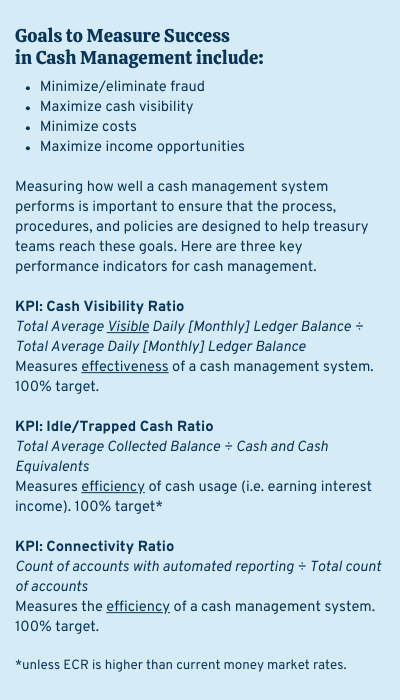The treasury team is responsible for the bank accounts used to collect, disburse, and ideally concentrate funds. As a part of the cash management function, it plays a vital role in the day-to-day operations, as well as building a strategic treasury function overall in municipal finance. Treasury teams cannot manage financial holdings without financial information. Therefore, retrieving bank information reporting, or bank polling, is one of the top tasks for the treasury team, according to the AFP. On the operational level, polling the bank to retrieve prior and intraday (current) reporting is the initial step in daily cash positioning. Having visibility of an organization’s cash position is the foundation of cash management and a crucial part of fraud prevention.
Definition: Bank Polling
The cash management process of connecting to financial institutions, manually or automatically, to access the information reporting services to retrieve account balances and transaction details.
In order to poll cash management accounts, municipal finance teams must connect to their banking partners’ systems via secure methods to protect the delivery of account balance and transaction data.  The most direct way the public sector connects its system is via bank portals, which are accessible online and through mobile devices. These portals are built and maintained by financial institutions for their customers. The commercial banks that offer cash management services provide a wide range of products and information via the portals.
The most direct way the public sector connects its system is via bank portals, which are accessible online and through mobile devices. These portals are built and maintained by financial institutions for their customers. The commercial banks that offer cash management services provide a wide range of products and information via the portals.
Bank portals are a beneficial tool but also come with some drawbacks. The main advantages of these portals include convenience and cost. Though they are easily accessible with login information, retrieving and analyzing the financial information is a manual, time-consuming process. It can quickly become a disadvantage for organizations with multiple banking relationships. Each portal will have its own login and security requirements, as well as different information reporting standards. The disparate information can be a headache when the treasury team needs to determine their cash position that is spread across different banks.
Accessing account balances and transactions can be automated. There are two key considerations in automating bank connectivity: Protocols and Formats.
Bank Connectivity Protocols
Automating the process of accessing cash management information can be done through a treasury management system (TMS). A TMS is software that governments, schools, and nonprofits use to integrate their banking data and still requires connecting to each bank’s reporting system.
The process and rules outlined for connecting to a bank’s reporting system is known as a protocol. Banks select the protocols to send and receive financial information. Bank connectivity protocols include:
- Host-to-host file transmission
- SWIFT
- API (Application Programming Interface)
The most prevalent protocol in the U.S. is SSH File Transfer Protocol (SFTP), a form of host-to-host transmission. API protocol is a more recently available option that enables software to communicate with each other directly. The SFTP method of transferring data uses files (often in bulk data transfers), while an API allows applications or services to interact with one another (real-time data flow). In simple terms, the main difference between SFTP and API is the way the data is transferred: SFTP securely carries files between two systems on a schedule whereas an API acts as a messaging channel, allowing data to flow in real-time.
TMS software is designed to access multiple bank reporting platforms, which allow organizations to centralize cash management activities into a single system versus separate online portals. Since their creation, these systems have added functionality related to the other treasury areas, including debt and investment management. However, they are mainly designed for the private sector, not municipal finance. The most advanced systems can also assist with foreign exchange, supply chain finance, trade finance, and other risk management activities.
Some enterprise resource planning softwares (ERPs) also have capabilities to provide cash management through modules. They have similar functionality as a TMS while using the ERP’s interface. Ultimately, a full-service TMS or ERP treasury module offers more functions than required by most public sector organizations. The inclusion of modules that are unnecessary for governments or schools often drives up the cost of the platform subscriptions.
Another option is to work with a multibank connectivity provider, or treasury aggregator, that specializes in consolidating bank reporting into a single protocol. In doing so, organizations can simplify and automate their connectivity into a single stream which can be directed to a TMS, ERP, or proprietary cash management system. It could also standardize data collection from multiple financial platforms, allowing organizations to collect and export their cash management information onto any other platform. Using a treasury aggregator creates more flexibility both in choosing banking partners and cash management systems.
Bank Connectivity Formats
Through their own product development, banks will determine the protocols they’re able to send different file formats through. This means, not only is a municipal finance team selecting a banking partner(s), but they’re also selecting the bank protocols and file formats.
It’s important to take a holistic approach by considering what banking partners and protocols fit best with an organization’s existing financial management technology (ERP, TMS) and other internal IT requirements. Knowing how files will be transferred from one system to another allows for the correct transformation of data into human-readable formats by a cash management system. If the file formats aren’t considered, the systems won’t be able to communicate, causing data to be transferred incorrectly, in an unreadable state, or not at all.
Standardized formats provide the syntax to be used to simplify the consolidation of information from multiple banks. There is formatting specific for cash management reporting (e.g. BAI2, EDI, XML, SWIFT) as well as for payments (e.g. NACHA, CSV, XML, SWIFT). Some financial institutions also use proprietary file formats sometimes required for specific products.
From a reporting perspective, the predominant file format that U.S. banks select is BAI2 sent via SFTP. BAI2 is a cash management balance reporting specification to retrieve prior day or intraday reporting on the balance and transaction details of their accounts. The Bank Administration Institute developed this file format (and BAI1 previously) in response to customers’ need for more extensive reporting of greater transaction detail across multiple banking relationships.
However, BAI2 is a text based flat file with limited functionality. With the ISO 20022 format, an XML (eXtensible Markup Language) based format, the financial industry is moving towards a file format with greater functionality. ISO 20022 is becoming an industry standard that allows organizations to communicate with both U.S. and non-U.S. based financial institutions, send multiple payment types, and receive remittance information from multiple sources all in one file. While the XML file format allows for more robust data to be shared between organizations and financial institutions - which may be more than is needed by the public sector - continued or accelerated adoption by banking partners is a factor that may affect decision-making today.
Implementation of Bank Connections
Setting up new connections or file formats can take significant time and effort for any treasury team and will vary from bank to bank. SFTP involves defining transmission standards, building and testing file formats, and aligning IT resources between an organization and its bank to ensure secure end-to-end encryption. These implementations can be complex and time-consuming, normally taking six to eight weeks to complete.
One factor impacting the implementation time and complexity is the choices organizations can make regarding the type of information they utilize. As mentioned earlier, connection formats are for information reporting and payments. For reporting purposes, projects tend to be quicker as the bank is only sending information back to the organization, while payment files sent from organizations to banks will take longer given the risks and complexity associated. Additionally, organizations can also select between intraday day, prior day reporting, or both. Many public sector treasury teams select a mixed approach, relying on automated feeds of prior day reporting for cash reconciliations, while manually accessing intraday information to perform cash positioning. While the mixed approach of automated and manual reporting eases the administrative burden of bank account reconciliation, it creates a less efficient cash management system with negative downstream impacts on cash forecasts and cash budgeting.
In summary, choosing the right banking partner is a key decision for a treasury team to make, which will drive the protocol(s) for accessing financial information for the years or decades to come. Protocols determine whether the process is manual or automated. If automated, the treasurer can speed up the flow of information and create better cash visibility.
Related Municipal Finance Reading
- DebtBook's Premium/Discount Amortization Methodology Explained
- Advance Refundings - The Muni Gamble
- A 'Game Changer' for the City of Memphis
Disclaimer: DebtBook does not provide professional services or advice. DebtBook has prepared these materials for general informational and educational purposes, which means we have not tailored the information to your specific circumstances. Please consult your professional advisors before taking action based on any information in these materials. Any use of this information is solely at your own risk.







.jpg)
.jpg)
.jpg)
